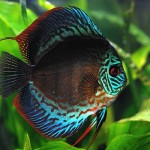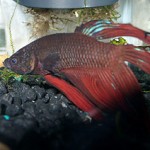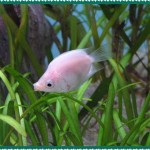guppy fish are fantastic for individuals who are just starting out as aquarists. They are considered to be easy going, and non-aggressive in temperament. Most importantly, they are hardy fish and very forgiving to novices who may be first time fish owner.
Guppy Fish Or Poecilia Reticulata
Scientifically known as the Poecilia reticulata, the guppy was first discovered in fresh and salty waters of Central and South America. They quickly garnered the nickname, millionfish, because of their ability to reproduce quickly and in large bunches. Since their discover, the guppy has been introduced to every continent with the exception of Antarctica.
What fascinates many fish enthusiasts is the variety within the guppy breed. Females tend to be larger then their male counterparts at 1.5 to 2.5 inches long. The males are smaller at approximately 1.0 to 1.5 inches, but they tend to be more colorful.
The females are predominately a gray color, although they can have some variations to their color and pattern. Male guppies tend to be brighter and take on colors of red, green, and blue with spots and stripes on their body. These variations make breeding new combination of guppy particularly popular amongst aquarists.
Communal Fish
Guppies are a communal fish, making this an attractive trait to fish lovers. They exist peacefully with other guppies, preferring to be together rather then alone in a tank. Unfortunately, they do not live well with all types of fish, particularly those that are larger and more likely to take nibbles to their tails. Whenever selecting fish to put together with in an aquarium it is imperative to sit down and research if the fish you plan to purchase will interact well or if one may act as a predator to another.
Guppy Fish Supplies
When starting out as a guppy fish owner there are several essential supplies to keep them happy and healthy. The first item is the most obvious, an aquarium. What may not be as obvious is what size aquarium to purchase. A lone guppy should have an aquarium no less then 5 gallons. With a group of guppies a 10 to 20 gallon tank is optimal.
The second and third supplies work together; a heater and a thermometer. Water temperature within the tank should remain around 75 to 82 degrees Fahrenheit in order to emulate their natural environment. Temperatures cooler or warmer then this may be detrimental to the guppy, often causing them stress.
The fourth supply is equally important to keeping the aquarium similar to their natural environment, and that is a pH indicator. Coming most often from warm, salty waters, guppies prefer living in a pH environment between 6.8 and 7.6. To keep up the salt water levels the best ration is one tablespoon of salt to every five gallons of water. In addition, and air stone helps force oxygen into the water that the fish desperately need.
The environment of the aquarium would not be complete without the fifth supply, which are plants, rocks, and branches. The little nooks and crannies these aquarium decorations provide the guppies with a safe place to rest and hide.
Sixth, an aquarium should have a filter. These come in various forms, and the two most suited for guppies are the large sponge filter and the inside box filter.
Finally, tank gravel, a fish net, and an algae scrubber, are important to maintaining a guppy aquarium.
Fully matured guppies are not to be fed more then twice a day. Overfeeding the fish leads to uneaten food collecting in the water and becoming a pollutant. Tropical fish flakes work well, but live food is more nourishing to guppies. Popular live foods include brine shrimp, fruit flies, algae, and cut up earthworms.
Guppies feeding habits are part of the reason they are introduced into many natural environments. They tend to enjoy eating mosquito larvae. In areas that experience malaria outbreaks, a popular mosquito control method is to bring guppies into their breading grounds. This has had some adverse affects on other fish species in some water systems that compete for other feeding resources. However, it remains as a low cost, effective mosquito elimination method for many parts of the world.
Guppy fish are popular amongst beginning aquarists who are learning how to breed fish. Guppies perform live-birthing rather then laying eggs. Their young are referred to as fry. Pregnant guppies should be transferred to their own aquarium to birth, or have a birthing net in a tank with small holes that the fry are able to swim through, but the mature guppies are unable to penetrate. Once a female guppy gives birth, she should be returned to the other adult guppy population.
The fry should have up to 5 gallons of their own aquarium space. They are able to eat much of the same foods as the mature guppies, and should not be introduced to the adults until they are at least one inch in size, which will take approximately 3 to 4 months. During this period of time, the fry will require 4 to 5 feedings a day.
The gestation period for guppies is relatively short and lasts between three and four weeks. The best way to tell if a guppy is about to give birth is visual and easy to spot. Before birth, the eyes of the fry can be seen through the mother’s translucent skin outstretched on her body. During birth, the fry are dropped from the mother’s body and immediately have survival instincts, as they will swim to a safe spot. The birth process will take roughly an hour and result in between two and fifty fry.
Older guppies will want to eat the fry, including potential their mother. This is why the breading net in a tank is important and allows to the fry to swim through safely after birth to find a safe spot. Separating the female when giving is also important because male guppies will sometimes attack the female when she is giving birth. Immediately after conceiving the fry, the mother should be returned to the mature guppies.
The variety and ease of raising guppy fish makes them fantastic for anyone who is looking to start raising fish.

















Leave a Reply